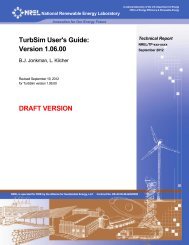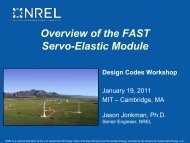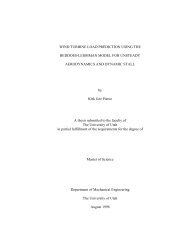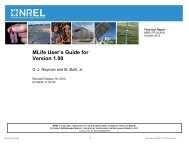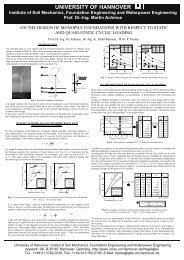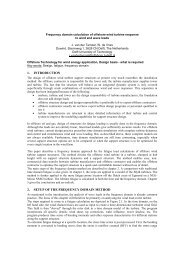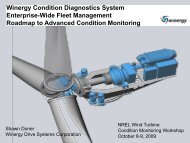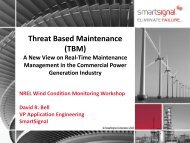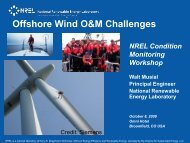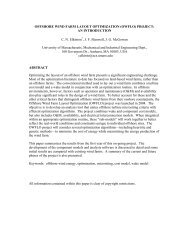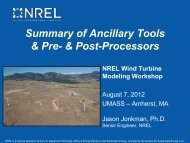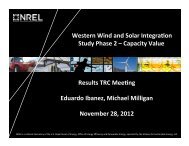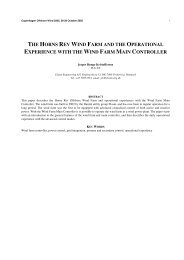NREL Power point slide template - cover and main slide
NREL Power point slide template - cover and main slide
NREL Power point slide template - cover and main slide
- No tags were found...
Create successful ePaper yourself
Turn your PDF publications into a flip-book with our unique Google optimized e-Paper software.
Investigation of Various Wind Turbine<br />
Drivetrain Condition Monitoring<br />
Techniques<br />
Shawn Sheng<br />
Senior Engineer, <strong>NREL</strong>/NWTC<br />
Wind Turbine<br />
Condition Monitoring Workshop<br />
October 8-9 2009<br />
<strong>NREL</strong> is a national laboratory of the U.S. Department of Energy Office of Energy Efficiency <strong>and</strong> Renewable Energy operated by the Alliance for Sustainable Energy, LLC
National Renewable Energy Laboratory<br />
Innovation for Our Energy Future<br />
Outline<br />
• Introduction<br />
• Drivetrain condition monitoring (CM)<br />
• Approach<br />
• Rationale<br />
• Implementation<br />
• Preliminary results
National Renewable Energy Laboratory<br />
Innovation for Our Energy Future<br />
Introduction: Subsytem Down Time<br />
Stop Hours<br />
70000<br />
65000<br />
60000<br />
55000<br />
50000<br />
45000<br />
40000<br />
35000<br />
30000<br />
25000<br />
20000<br />
15000<br />
10000<br />
5000<br />
0<br />
Wind Stats: 2003-2006 Stop Hours per Turbine Subsystem<br />
Rotor<br />
Air Brake<br />
Mech. Brake<br />
Pitch Adjust.<br />
Main shaft/bearing<br />
Gearbox<br />
Generator<br />
Yaw System<br />
Windvane/anemometer<br />
Elec. Controls<br />
Elec. System<br />
Hydraulics<br />
Sensors<br />
• Need to<br />
reduce<br />
drivetrain<br />
down time:<br />
replace<br />
traditional<br />
time-intervalbased<br />
<strong>main</strong>tenance<br />
with conditionbased<br />
<strong>main</strong>tenance<br />
(CBM)<br />
Credit : Francisco Oyague
Introduction: Condition Monitoring<br />
National Renewable Energy Laboratory<br />
Innovation for Our Energy Future<br />
• One information source to achieve CBM:<br />
Condition Monitoring (CM)<br />
• Benefits of CM:<br />
• Early deterioration detection can avoid catastrophic<br />
failure<br />
• Accurate evaluation of damage will enable costeffective<br />
<strong>main</strong>tenance planning<br />
• Root-cause analysis can improve operational<br />
strategy<br />
• Increased turbine operational hours<br />
Credit : Chris Walford <strong>and</strong> Don Roberts, EPRI Report
National Renewable Energy Laboratory<br />
Innovation for Our Energy Future<br />
Gearbox Reliability Collaborative (GRC)<br />
• Two identical test<br />
gearboxes: one<br />
for dynamometer<br />
<strong>and</strong> the other for<br />
field test<br />
• Dynamics<br />
measurement:<br />
more than 120<br />
channels of<br />
internal<br />
instrumentation<br />
• CM: both<br />
dynamometer<br />
<strong>and</strong> field tests
National Renewable Energy Laboratory<br />
Innovation for Our Energy Future<br />
Drivetrain CM: Approach & Rationale<br />
• Approach<br />
• A combination of acoustic emission (specifically stress<br />
wave), vibration <strong>and</strong> lubricant CM techniques.<br />
• Rationale<br />
• Each technique has its own strengths <strong>and</strong> limitations.
Dynamics CM: Implementation<br />
• SwanTech<br />
• One of the few commercial<br />
packages using ultrasonic<br />
range signals for CM<br />
• CM experience in wind industry.<br />
• SKF<br />
• One of the best vibration CM<br />
systems among interested<br />
participants<br />
• Huge bearing database benefited<br />
from being a <strong>main</strong> bearing<br />
supplier to wind turbines<br />
• CM experience in wind industry.<br />
National Renewable Energy Laboratory<br />
Source: SwanTech (with permission)<br />
Source: SKF (with permission)<br />
Innovation for Our Energy Future
Oil CM: Implementation<br />
• Kittiwake<br />
• Multiple parameters obtained by<br />
one compact package<br />
• No limitation on flow rates.<br />
• Macom<br />
• Five bins of both<br />
ferrous <strong>and</strong> nonferrous<br />
particle sizes<br />
• Flow rate matches<br />
the kidney loop<br />
specifications.<br />
• Hydac<br />
• Provide ISO 4406 cleanliness level readings<br />
• Experience with lubricant Castrol OptiGear X320.<br />
National Renewable Energy Laboratory<br />
Source: Macom (with permission)<br />
Source: Kittiwake (with permission)<br />
Source: Hydac (with permission)<br />
Innovation for Our Energy Future
Dynamometer Test Implementation<br />
• Periodic oil sample analysis:<br />
• Obtain information not provided by oil CM systems<br />
<strong>and</strong> correlate with oil CM system readings.<br />
National Renewable Energy Laboratory<br />
Innovation for Our Energy Future
Field Implementation<br />
For both dynamometer <strong>and</strong> field tests, most<br />
CM data is remotely accessible using a web<br />
National Renewable Energy Laboratory<br />
Innovation for Our Energy Future
Preliminary Results: Vibration (Dyno)<br />
• Capable of detecting:<br />
• gear mesh, shaft<br />
rotational, bearing<br />
characteristic<br />
frequencies.<br />
• Trending of these<br />
frequencies :<br />
• changes in<br />
condition of<br />
monitored<br />
components (e.g.,<br />
bearing).<br />
National Renewable Energy Laboratory<br />
Innovation for Our Energy Future
Preliminary Results: Stress Wave (Dyno)<br />
• Two pairs of strong<br />
correlations:<br />
• rpm with SWE at <strong>main</strong><br />
bearing <strong>and</strong> generator<br />
• Dyno motor power <strong>and</strong><br />
SWE at ring/helical<br />
gears.<br />
• SWE might be useful<br />
for inferring driving load<br />
to the gearbox, if<br />
measurement is not<br />
available.<br />
National Renewable Energy Laboratory<br />
Innovation for Our Energy Future
Preliminary Results: Oil<br />
• A broad range of<br />
particles generated:<br />
• all three bins<br />
• wind turbine gearboxes<br />
always emit particles.<br />
• Contamination level:<br />
• increases with ramping up of generator speed<br />
• decreases with shutdown of the generator <strong>and</strong> a<br />
continuously functional lubricant filtration system<br />
• might be useful as an indictor for run-in of gearboxes.<br />
National Renewable Energy Laboratory<br />
Innovation for Our Energy Future
Preliminary Results: Oil (Cont.)<br />
• Other oil CM systems:<br />
• No subtle changes: might be designed for long-term<br />
operations, not applicable for run-in.<br />
National Renewable Energy Laboratory<br />
Innovation for Our Energy Future
National Renewable Energy Laboratory<br />
Innovation for Our Energy Future<br />
Vibration (Field) : Speed Trends<br />
Credit : SKF
Generator Bearing DE <strong>and</strong> NDE Trends<br />
National Renewable Energy Laboratory<br />
Innovation for Our Energy Future<br />
Credit : SKF
National Renewable Energy Laboratory<br />
Innovation for Our Energy Future<br />
Generator DE Enveloping<br />
Abnormal cage <strong>and</strong> ball spinning frequencies observed<br />
Credit : SKF
Stress Wave (Field) : Generator DE<br />
National Renewable Energy Laboratory<br />
Innovation for Our Energy Future
National Renewable Energy Laboratory<br />
Innovation for Our Energy Future<br />
Oil CM (Field)
Lessons Learned So far<br />
• Each technique has its own pros <strong>and</strong> cons<br />
• Confidence in diagnostics can be increased by<br />
fusing different techniques, typically oil with<br />
vibration or acoustic emission<br />
• Data interpretation is critical for achieving correct<br />
diagnostics results <strong>and</strong> subsequently appropriate<br />
O&M strategies<br />
• Fully automatic action recommendation from<br />
online CM systems appears challenging<br />
National Renewable Energy Laboratory<br />
Innovation for Our Energy Future
National Renewable Energy Laboratory<br />
Innovation for Our Energy Future<br />
Thank you!<br />
NOTICE: This presentation was prepared as an account of work<br />
sponsored by an agency of the United States government. Neither the<br />
United States government nor any agency thereof, nor any of their<br />
employees, makes any warranty, express or implied, or assumes any legal<br />
liability or responsibility for the accuracy, completeness, or usefulness of<br />
any information, apparatus, product, or process disclosed, or represents<br />
that its use would not infringe privately owned rights. Reference herein to<br />
any specific commercial product, process, or service by trade name,<br />
trademark, manufacturer, or otherwise does not necessarily constitute or<br />
imply its endorsement, recommendation, or favoring by the United States<br />
government or any agency thereof. The views <strong>and</strong> opinions of authors<br />
expressed herein do not necessarily state or reflect those of the United<br />
States government or any agency thereof.



